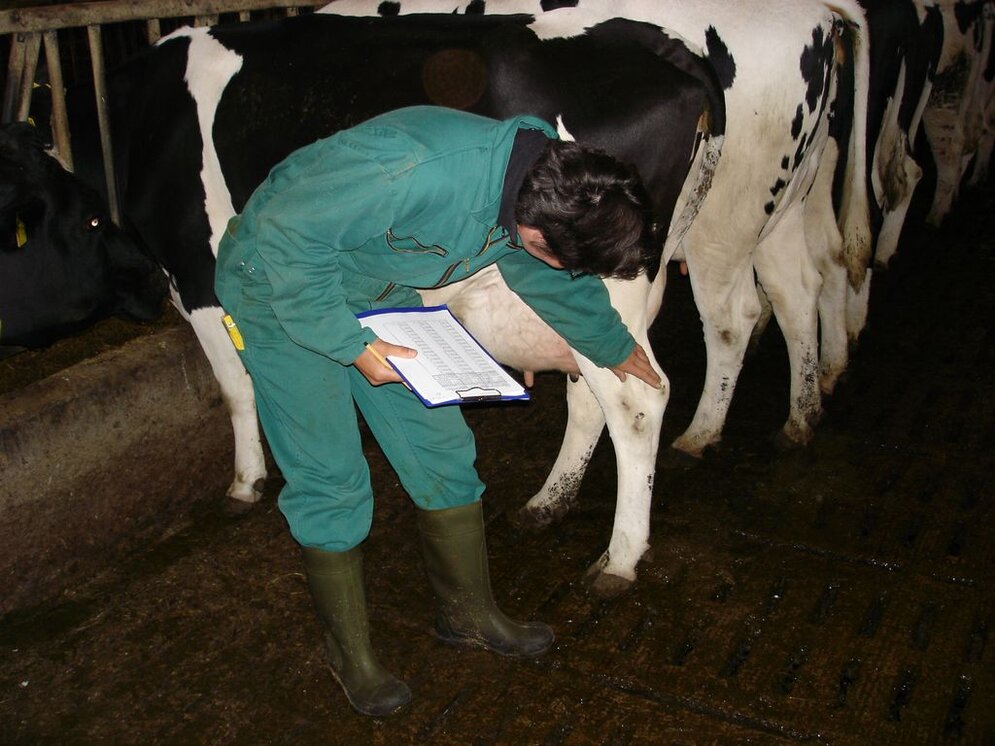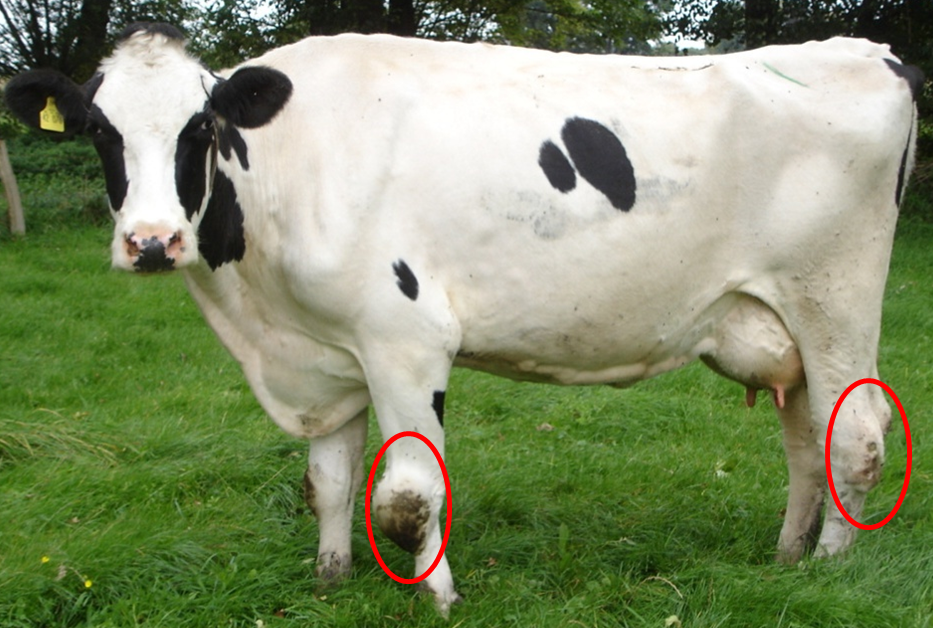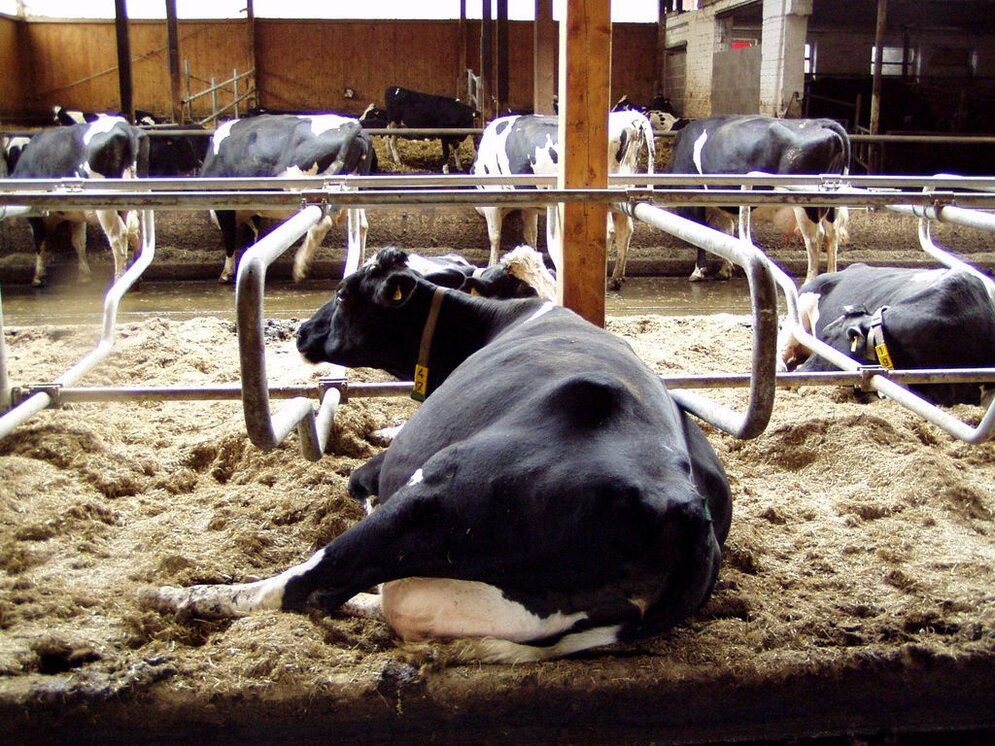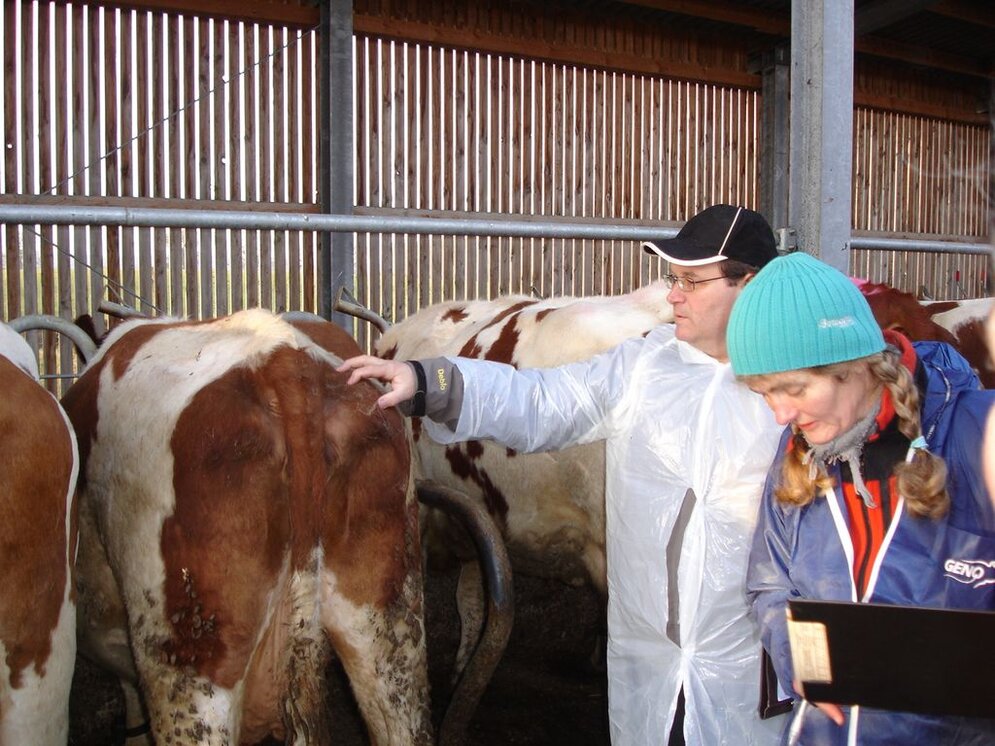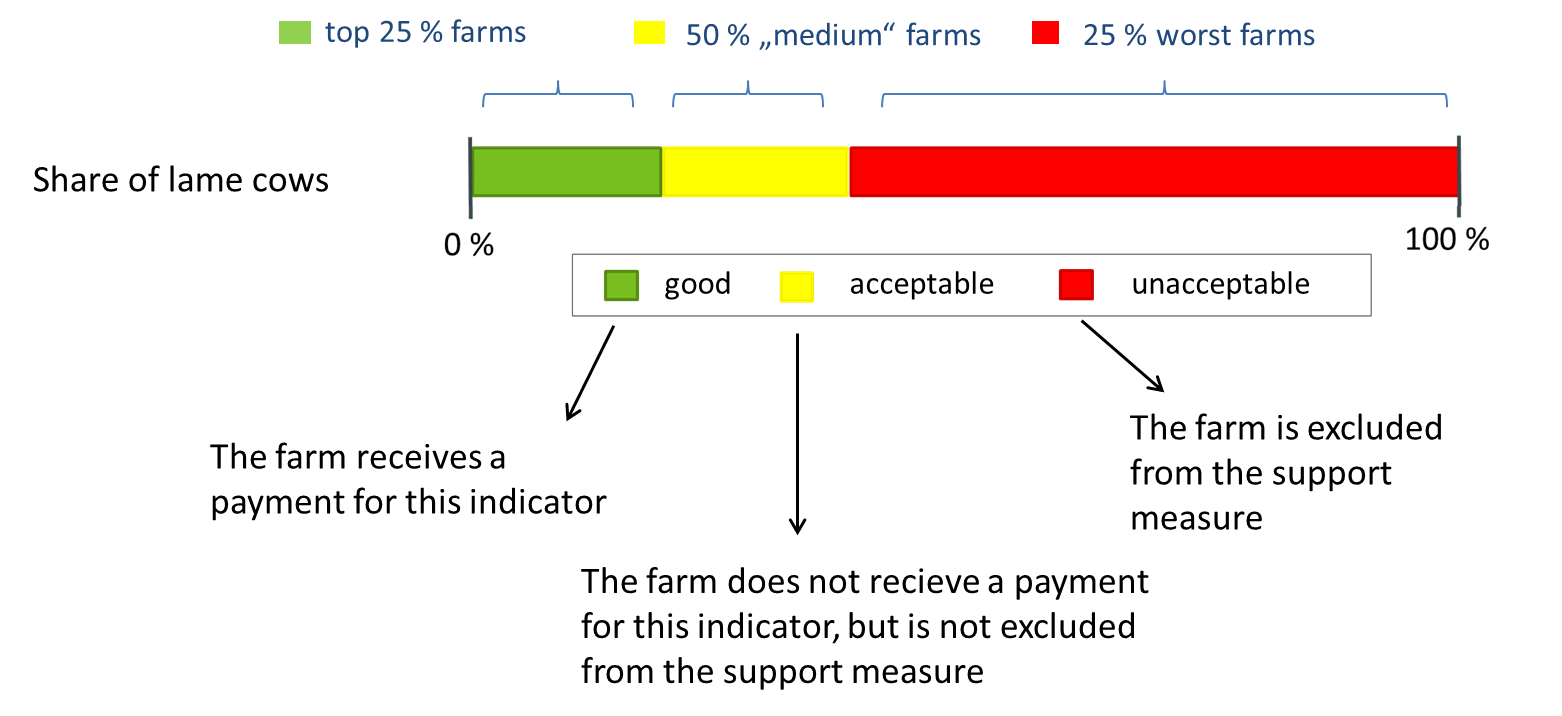Project
Welfare friendly dairy farming – towards a result-oriented measurement and support
Indicators for a Payment-by-Results Approach for Animal Welfare Measures and Organic Farming
According to Eurobarometer surveys, most consumers desire adequate housing and living circumstances for farm animals. But which indicators are most suitable for the measurement of animal welfare and how can animal welfare policies be implemented in a result-oriented way? This research question is adressed by the Thünen-Insitut of Organic Farming and the Thünen-Institut of Farm Economics.
Background and Objective
Regulations in organic farming and in animal welfare policies are action-oriented: they refer to resources such as space allowance and management, i.e. access to pasture. With this approach, the prerequisites for the exercise of normal behaviour can be created; but the actual state of animal health and behaviour are largely left out. The aim of our project is to develop a concept for a result-oriented approach to improve animal welfare. One of the challenges is the selection of suitable indicators. Exemplarily for dairy, we will suggest a set of indicators, approved by scientists and practitioners, which address major welfare issues in dairy farming.
Approach
To select indicators which address major welfare-problems in dairy farming, we carried out a two-phased sampling process:
First, scientists from Germany, Switzerland and Austria were asked in a written survey to select the most appropriate from a list of 82 indicators derived from literature. The questionnaire was designed as a Delphi survey to reduce heterogeneity among researchers and resulted in a list of 23 indicators.
Then a practitioner-workshop with farmers, lobby groups, administration and control took place to address practicability issues. With great match, a list of 10 indicators was adopted. The selected indicators as well as other animal and resource based indicators, including the Welfare Quality Assessment Protocol for Dairy Cows were collected on 115 dairy farms in Germany.
Further steps were the development and discussion of a of target- and threshold value system for support measures and organic farming.
Data and Methods
In addition to the selected indicators, the following information is assembled on the farms:
• the complete WQ protocol
• information from the milk control system (i.e. udder health),
• data (e.g. mortality) from the Identification and Information System for Animals (HIT), and
• resource based indicators for the classification of housing systems (National Assessment Catalogue for Animal Husbandry-NACAH).
In our project, we follow an interdisciplinary approach and apply quantitative and qualitative methods to generate and analyse the empirical data.
Results
Within the framework of the project, 10 indicators were identified for a result-oriented animal welfare support measure for dairy cattle farms. Since the selected indicators relate exclusively to the "health" dimension of animal welfare, a combination of action- and result-oriented elements is recommended for the design of a policy support measure. The action oriented requirements should include, for example, access to pasture, the animal-cubicle ratio and the use of sedation, local anesthetics and analgesics when disbudding/dehorning. In this way, the integration of the three animal welfare dimensions: animal health, animal behaviour and emotional state can be achieved.
The 10 indicators selected for the animal welfare policy measure are:
The share of cows
(1) with clinical lameness,
(2) with carpal / tarsal changes,
(3) which are very lean (body condition score),
(4) with integument alterations,
(5) with broken tails,
(6) which are dirty (cleanliness),
(7) with a milk somatic cell count> 400,000 ml-1,
(8) with a fat protein quotient (FPQ) ≥ 1.5 in the early lactation,
(9) with a FEQ <1,0 and
(10) the mortality of cows.
In the case of action-oriented measures, the payment of support premia requires compliance with the funding requirements. For result-oriented measures, the farmers need to achieve defined target values. On the basis of the indicator values collected on the farms, a target system has been developed, which is illustrated in the figure using the indicator lameness as an example.
When participating in the result-oriented animal welfare support measure the farms should:
- receive a premium for those indicators, for which the farm is among the 25% best,
- receive no premium but will not be excluded from the measure for those indicators, for which the farms result corresponds to the average 50% of the holdings,
- be excluded from the measure if the farm is among of the 25% worst with more than one indicator.
In organic farming, instead of a premium system, sanctions could take effect: analogous to the eligibility criteria described, farms with problematic indicator values could be obliged to take part in compulsory counseling or be excluded from ecological labeling.
For the implementation of a combined action- and result-oriented aninal welfare support measure, a scientifically accompanied "trial phase" with a limited number of participating farms is recommended.
Thünen-Contact

Involved Thünen-Partners
Funding Body
-
Federal Office for Agriculture and Food (BLE)
(national, öffentlich)
Duration
9.2012 - 3.2016
More Information
Project funding number: 2811NA026
Funding program: Bundesprogramm Ökologischer Landbau und andere Formen nachhaltiger Landwirtschaft (BÖLN)
Project status:
finished
Publications to the project
- 0
Bergschmidt A, March S, Wagner K, Brinkmann J (2021) A results-oriented approach for the animal welfare measure of the European Union’s rural development programme. Animals MDPI 11(6):1570, DOI:10.3390/ani11061570
- 1
Wagner K, Brinkmann J, Bergschmidt A, Renziehausen C, March S (2021) The effects of farming systems (organic vs. conventional) on dairy cow welfare, based on the Welfare Quality® protocol. Animal 15(8):100301, DOI:10.1016/j.animal.2021.100301
- 2
Bergschmidt A, March S, Mohr R, Renziehausen C, Wagner K, Brinkmann J (2019) Entwicklung einer ergebnisorientierten Tierwohl-Fördermaßnahme für Milchkühe. Ber Landwirtsch 97(2), DOI:10.12767/buel.v97i2.236
- 3
Bergschmidt A, Brinkmann J, Renziehausen C, March S (2017) Evaluating 'Animal Welfare Payments' of the EUs Common Agricultural Policy. In: Jong IC, Koene P (eds) Proceedings of the 7th International Conference on the Assessment of Animal Welfare at Farm and Group Level : WAFL 2017 ; Ede, The Netherlands ; September 5-8, 2017. Wageningen: Wageningen Academic Publ, p 168
- 4
March S, Brinkmann J, Renziehausen C, Bergschmidt A (2017) Indicators for a result-oriented approach for animal welfare policies and organic farming. In: Jong IC, Koene P (eds) Proceedings of the 7th International Conference on the Assessment of Animal Welfare at Farm and Group Level : WAFL 2017 ; Ede, The Netherlands ; September 5-8, 2017. Wageningen: Wageningen Academic Publ, p 178
- 5
March S, Bergschmidt A, Renziehausen C, Brinkmann J (2017) Indikatoren für eine ergebnisorientierte Honorierung von Tierschutzleistungen. Bonn: BÖLN, 280 p
- 6
Bergschmidt A, March S, Renziehausen C, Brinkmann J (2017) Indikatoren für eine Tierwohlkontrolle in Fördermaßnahmen und in der ökologischen Milchviehhaltung. In: Wolfrum S, Heuwinkel H, Reents HJ, Hülsbergen KJ (eds) Ökologischen Landbau weiterdenken - Verantwortung übernehmen, Vertrauen stärken : Beiträge zur 14. Wissenschaftstagung Ökologischer Landbau, Freising-Weihenstephan, 7. bis 10. März 2017. Berlin: Köster, pp 506-509
- 7
Bergschmidt A (2017) Tierwohl - Definitionen, Konzepte und Indikatoren. Land Raum 30(3):4-6
- 8
Brinkmann J, March S, Bergschmidt A, Renziehausen C, Starosta S, Osterbuhr M, Wagner K (2017) Untersuchungen zum Einfluss der Wirtschaftsweise auf das Tierwohl von Milchkühen auf Basis des Welfare Quality Protokolls. In: Wolfrum S, Heuwinkel H, Reents HJ, Hülsbergen KJ (eds) Ökologischen Landbau weiterdenken - Verantwortung übernehmen, Vertrauen stärken : Beiträge zur 14. Wissenschaftstagung Ökologischer Landbau, Freising-Weihenstephan, 7. bis 10. März 2017. Berlin: Köster, pp 510-514
- 9
Brinkmann J (2015) Geht es Kühen auf Bio-Betrieben besser? : Interview. Elite(6):5
- 10
Zapf R, Schultheiß U, Achilles W, Schrader L, Knierim U, Herrmann HJ, Brinkmann J, Winckler C (2015) Indicators for on-farm self-assessment of animal welfare - Example: dairy cows. Landtechnik Agric Eng 70(6):221-230, DOI:10.15150/lt.2015.2678
- 11
Zapf R, Schultheiß U, Achilles W, Schrader L, Knierim U, Herrmann HJ, Brinkmann J, Winckler C (2015) Indikatoren für die betriebliche Eigenkontrolle auf Tiergerechtheit - Beispiel Milchkühe. Landtechnik Agric Eng 70(6):221-230, DOI:10.15150/lt.2015.2678
- 12
Brinkmann J, March S, Wagner K, Renziehausen C, Starosta S, Osterbuhr M, Bergschmidt A (2015) Indikatoren für eine ergebnisorientierte Honorierung von Tierschutzleistungen in der Milchviehhaltung. In: Häring AM, Hörning B, Hoffmann-Bahnsen R, Luley H (eds) Beiträge zur 13. Wissenschaftstagung Ökologischer Landbau "Am Mut hängt der Erfolg: Rückblicke und Ausblicke auf die ökologische Landbewirtschaftung". pp 451-454
- 13
Brinkmann J, March S, Wagner K, Renziehausen C, Starosta S, Osterbuhr M, Bergschmidt A (2015) Indikatoren für eine ergebnisorientierte Honorierung von Tierschutzleistungen in der praktischen Milchviehhaltung. In: Gieseke D, Busch G, Ikinger C, Kühl S, Pirsich W (eds) Tierhaltung im Spannungsfeld von Tierwohl, Ökonomie und Gesellschaft : Tierwohl-Tagung in Göttingen ; 7.-8. Oktober 2015. Göttingen: Universität Göttingen, Department für Agrarökonomie und Rurale Entwicklung, pp 30-33
- 14
Brinkmann J (2015) Tatsächlich erbrachte Leistung fördern : [Interview]. DLG Mitt 130(8):87
- 15
Zapf R, Schultheiß U, Achilles W, Schrader L, Knierim U, Herrmann HJ, Brinkmann J, Winckler C (2015) Tierschutzindikatoren : Vorschläge für die betriebliche Eigenkontrolle. Darmstadt: KTBL, 68 p, KTBL Schr 507
- 16
Bergschmidt A, Renziehausen C, March S, Brinkmann J (2015) Tierschutzwirkungen der Entwicklungsprogramme für den ländlichen Raum - Ergebnisse aus der Evaluierung der Maßnahme "Förderung umwelt- und tiergerechter Haltungsverfahren". In: Kuratorium für Technik und Bauwesen in der Landwirtschaft (ed) Herausforderung Tierwohl : KTBL-Tagung vom 13. bis 15. April 2015 in Halle (Saale). Darmstadt: KTBL, pp 208-213
- 17
Bergschmidt A, Renziehausen C, Brinkmann J, March S (2014) Application of the welfare quality protocols for the evaluation of agricultural policies [Poster]. In: Mounier L, Veissier I (eds) Proceedings of the 6th International Conference on the Assessment of Animal Welfare at the Farm and Group Level : WAFL 2014 ; Clermont-Ferrand, France ; September 3-5, 2014. Wageningen: Wageningen Academic Publ, p 201
- 18
Brinkmann J, March S, Renziehausen C, Bergschmidt A (2014) Indicators for a result-oriented approach for animal welfare policies and organic farming [Poster]. In: Mounier L, Veissier I (eds) Proceedings of the 6th International Conference on the Assessment of Animal Welfare at the Farm and Group Level : WAFL 2014 ; Clermont-Ferrand, France ; September 3-5, 2014. Wageningen: Wageningen Academic Publ, p 88
- 19
Bergschmidt A, Renziehausen C, Brinkmann J, March S (2014) Tiergerechtheit landwirtschaftlicher Nutztierhaltung: Verbesserung durch ergebnisorientierte Honorierung? Ländl Raum (ASG) 65(2):32-33
- 20
Bergschmidt A, Renziehausen C (2013) Ergebnisorientierte Förderung von Tierschutzmaßnahmen: Welche Erkenntnisse aus dem Umweltbereich sind übertragbar? In: Grenzen der Qualitätsstrategie im Agrarsektor : 41. Jahrestagung der Schweizer Gesellschaft für Agrarwirtschaft und Agrarsoziologie & 23. Jahrestagung der Österreichischen Gesellschaft für Agrarökonomie : Tagungsband 2013 ; ETH Zürich, Zürich, 12.-14. September 2013. ÖGA, pp 101-102

